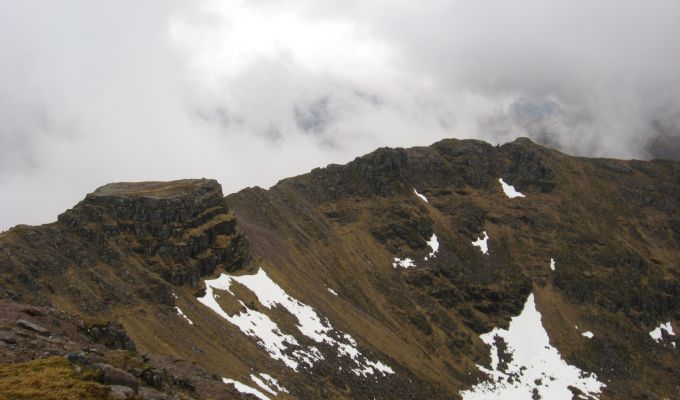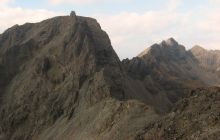CELEBRATING THE MOUNTAIN LEGACY OF SIR HUGH MUNRO
WE were sitting at the summit of Sgor Gaoith in the Cairngorms silently drinking in the views when another walker strolled up to the cairn. It was September, 1994.
He announced proudly: “Well, that's not a bad day – five Munros ticked.” Our first thought was that he was some kind of ultra-walker and had spent the day travelling over a huge distance.
We told him that was impressive – after all, we had only done the two, the Glen Feshie pair of Sgor Gaoith and Mullach Clach a' Bhlair. He seemed puzzled. “Did you not take in the other three?”
Now it was our turn to look puzzled. Then he rattled off his peaks for the day and the penny dropped – three were no longer Munros.
Geal-charn, Carn Ban Mor and Meall Dubhag had been re-classified as Munro Tops in the 1981 revision of the list, but he was still working from a book with the 1974 listings. Needless to say, he was somewhat crestfallen at that point.
The Munros, a constant source of inspiration, and, in some cases, frustration.
When Hugh Munro – he became Sir Hugh in 1913 – presented his list of mountains exceeding 3,000-ft to the Scottish Mountaineering Club in 1891, he had identified 283 mountains and 255 separate tops, a total of 538 summits. Since then, Munro's Tables have gone through a series of revisions, but they remain largely true to the spirit of their origin, and are the seminal guide to Scotland's highest mountains.
Munro acknowledged that his 1891 listings contained many anomalies, and he was working on a revision at the time of his death in March 1919. He had been working as a volunteer for the Red Cross after the First World War when he became a casualty of the post-war flu pandemic. He was 63. After his death, his family passed on his planned changes to the SMC and they incorporated many of his suggestions to produce an updated list in 1921.
This year marks the centenary of his death, and Munro's life and legacy to Scottish hillwalking are being celebrated with a major exhibition at the A K Bell Library in Perth. The Munro Legacy Exhibition opened in March and runs until May 31.
It has been driven by The Munro Society, and it is hoped after its Perth run the exhibition will move on other venues around the country. It has already been earmarked for the Dundee Mountain Film Festival in November.
One of the great ironies is that Munro never managed to complete his list. That honour went to the Reverend A E Robertson in 1901. He is regarded as the first Munroist, although he never scaled the Inaccessible Pinnacle, instead following Munro's list to the letter which had mistakenly registered the main, yet lower, peak of Sgurr Dearg as the summit. There is also confusion over whether Robertson managed to reach the top of Ben Wyvis.
It was 22 years before the next 'compleation' (the archaic spelling used to denote a successful ascent of every peak on the list), but by that time the Rev Ronald Burn was working from the revised 1921 figures. The number of Munros now stood at 276, seven less than originally recorded, but the number of Tops had risen by 12 for a grand total of 543. And this time, the In Pin was included, with the adjoining Sgurr Dearg having been correctly re-classified as a Top.
Munro made most of his calculations with a pocket-sized aneroid barometer, and the scale and accuracy of his work was remarkable for its time. But constantly evolving and improving mapping and measuring methods meant inconsistencies were highlighted and adjusted as and when they were deemed relevant.
Changes to the list are not always greeted with universal approval. There are even dissenting voices to any tinkering at all, a belief that Munro's original list is a historical document and is personal rather than definitive – the absence of any rules and consistency of height differential, for instance – and should stand as it was written.
It's a tricky balancing act, and many mountaineering luminaries have struggled with the task. For some, any change is one too many, for others, there have been too few changes. Little wonder that Hamish Brown referred to the Munros as “always changing, never changing”.
The introduction of metric measures has also caused some to question the modern relevance of a list of 3,000-ft mountains. The figure of 914.4 metres just doesn't have the same ring but, so far, any suggestion of presenting a fresh list based on the more rounded starting height of 1,000 metres has fallen on deaf ears. Rightly so: in that case the term Munros would, and could, no longer apply.
Height was not always the main factor used by Munro in deciding which was the main summit, as in the case of the In Pin, possibly seen as merely a protuberance on the side of the main mountain mass even though it stood higher. It's likely Munro would have approved of the opportunity to update and adjust his data with any means at his disposal.
It's interesting, but perhaps not surprising, that in these days where we are swamped by mountain lists, where every bump or swelling belongs to some category or other, that there are a few souls going back to basics. The Rev Robertson may have been the only person to have completed his round from Munro's original list, but there are now a few Munroists following in his footsteps and ticking their way round it.
One of the advantages of this, of course, is that there would be no need to scrabble up the Inaccessible Pinnacle to gain a 'compleation'. There are currently some 6,500 registered Munroists: I wonder how many more there would be if an ascent of the In Pin was not regarded as necessary to complete a round?
The original list featured 24 summits which are no longer classified as Munros; some are now Munro Tops, some have disappeared altogether, while others measured as the wrong summit have now been allocated to the correct point. Beinn an Lochain, that graceful Corbett in the Arrochar Alps, survived until the 1981 revision despite its height of 2957ft being quite a bit short of Munro requirements.
Then there's Carn Clioch-mhuillin, the Cairngorms summit on which Sir Hugh had planned to finish. That lends a certain poignancy to this peak, so it seems particularly cruel it was eventually deemed to be a Top after surviving as a Munro for 90 years.
For Munroists who haven't done all the Tops, there are a few treasures still to be discovered. Sgurr na Lapaich, out on the end of the Mam Sodhail ridge in Glen Affric, is a mountain which has been mooted as a contender to regain full Munro status for a long time since losing it in 1921, while Creag an Leth-choin (Lurcher's Crag), a distant yet prominent Top of Cairn Gorm, will be a welcome diversion.
Among the 19 Munros on the current list omitted first time round were three in Skye's Black Cuillin, so no need for the new purists to climb Am Basteir, Sgurr Mhic Choinnich or Sgurr a' Mhadaidh. Also missing were the Fisherfield pair Beinn Tarsuinn and Ruadh Stac Mor, although they never gained Munro status until the revisions of 1953 and 1974 respectively as this area had proven a notorious blank spot for map makers for years due to access problems.
The last major revision, in 1997, which promoted eight summits to Munro status taking the total to 284, caused a bit of a stir. These elevations were all on the big ridges, such as Beinn Eighe and Beinn Alligin in Torridon, Buachaille Etive Mor and Etive Beag and Bidean nam Bian in Glen Coe, the Five Sisters in Kintail, An Stuc in the Ben Lawers range, and Sgor an Lochain Uaine – The Angel's Peak – in the Cairngorms, were seen by the more cynical as an opportunity by the powers-that-be to sell more updated guide books.
On the other hand, it served as a lesson to anyone who had been foolish enough to have ignored these summits during any ascent just because they didn't have the Munro seal of approval at the time.
To say that the Munros list is a moveable feast would be somewhat of an understatement. There are many mountains which have seen their status swap back and forth with the regularity of a change of underwear.
An Gearanach in the Mamores was deemed a Munro, then a Top, then later a Munro again. The same happened with the aforementioned Sgor an Lochain Uaine, although it remained out in the cold from 1921 until the 1997 revision. Some ranges that had been over-endowed with Munros, such as the Ben Avon massif and the Newtonmore hills, have had them stripped down over the years. Glen Feshie also had an abundance, hence the Sgor Gaoith incident.
The case of Ben Lui is a supreme example of unnecessary tinkering. In the 1974 revision, it was decided to designate the North-west Top – which hadn't even been mentioned in any previous list – as the true summit. The next set of changes saw that decision correctly overturned and the NW Top only lasted a short time before being struck off again.
It's been more than 20 years since the last concerted revision, although the Munro tally has dropped to 282 in that time with new surveys leading to two mountains being re-classified as Corbetts – Sgurr nan Ceannaichean in 2009 and Beinn a' Chlaidheimh in 2012.
These surveys were driven by The Munro Society, a group set up in 2002 open to anyone who has 'compleated' the Munros, and were initially undertaken to determine whether any of the higher Corbetts could actually be of Munro height.
The project was eventually expanded to include all peaks around the 3,000-ft mark and stretched over eight years. Every so often, there were rumours that that mighty slab of crumbling rock in the far north, Foinaven, was actually of Munro height, but when it was finally checked it proved to be slightly lower than originally thought.
In fact, no 'new' Munros were found during these heightings, but satellite measurements showed that Sgurr nan Ceannaichean and Beinn a' Chlaidheimh were under the plimsol line and they were re-assigned to the Corbett clan.
A warning, though. A female friend told me she had been converted to hillwalking by her partner, and she was happy to spend her weekends tramping the hills in her search for true love. In all ended in tears, however, when he became obsessed with ticking everything in sight, including all the deleted Tops. This was a step too far for her, and during a long trek in the Monadh Liath the relationship came to an abrupt halt. It seems that while love may be said to conquer all, it couldn't quite conquer the deleted Munro Tops.
That these iconic mountains still continue to fascinate more than 100 years after their conception would likely have surprised and yet delighted Munro. The exhibition is a fitting tribute to the man regarded as the Father of Scottish hillwalking and his enduring legacy.

